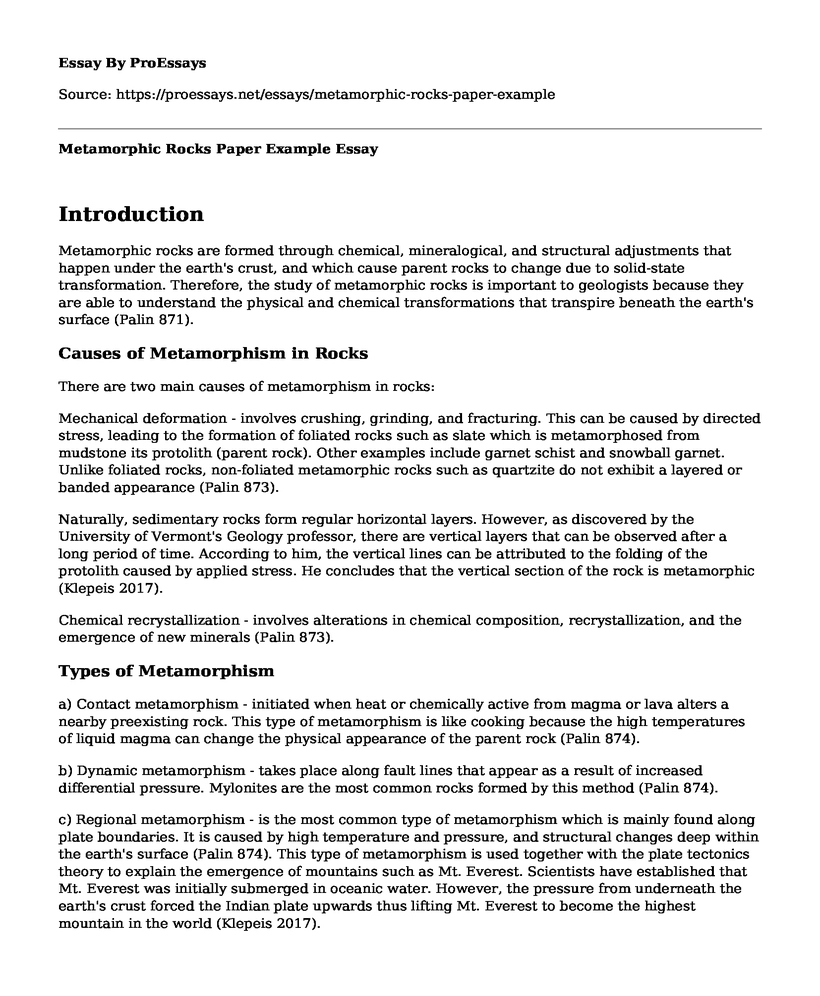Introduction
Metamorphic rocks are formed through chemical, mineralogical, and structural adjustments that happen under the earth's crust, and which cause parent rocks to change due to solid-state transformation. Therefore, the study of metamorphic rocks is important to geologists because they are able to understand the physical and chemical transformations that transpire beneath the earth's surface (Palin 871).
Causes of Metamorphism in Rocks
There are two main causes of metamorphism in rocks:
Mechanical deformation - involves crushing, grinding, and fracturing. This can be caused by directed stress, leading to the formation of foliated rocks such as slate which is metamorphosed from mudstone its protolith (parent rock). Other examples include garnet schist and snowball garnet. Unlike foliated rocks, non-foliated metamorphic rocks such as quartzite do not exhibit a layered or banded appearance (Palin 873).
Naturally, sedimentary rocks form regular horizontal layers. However, as discovered by the University of Vermont's Geology professor, there are vertical layers that can be observed after a long period of time. According to him, the vertical lines can be attributed to the folding of the protolith caused by applied stress. He concludes that the vertical section of the rock is metamorphic (Klepeis 2017).
Chemical recrystallization - involves alterations in chemical composition, recrystallization, and the emergence of new minerals (Palin 873).
Types of Metamorphism
a) Contact metamorphism - initiated when heat or chemically active from magma or lava alters a nearby preexisting rock. This type of metamorphism is like cooking because the high temperatures of liquid magma can change the physical appearance of the parent rock (Palin 874).
b) Dynamic metamorphism - takes place along fault lines that appear as a result of increased differential pressure. Mylonites are the most common rocks formed by this method (Palin 874).
c) Regional metamorphism - is the most common type of metamorphism which is mainly found along plate boundaries. It is caused by high temperature and pressure, and structural changes deep within the earth's surface (Palin 874). This type of metamorphism is used together with the plate tectonics theory to explain the emergence of mountains such as Mt. Everest. Scientists have established that Mt. Everest was initially submerged in oceanic water. However, the pressure from underneath the earth's crust forced the Indian plate upwards thus lifting Mt. Everest to become the highest mountain in the world (Klepeis 2017).
The formation of metamorphic rocks involves the restructuring of rocks. However, Geologists have discovered that the no elements are lost in the process. As such, the concept of metamorphic facies holds that any changes that take place during metamorphism are exclusively caused by changes in temperature and pressure (Klepeis 2017).
Applications of Metamorphic Rocks
Marble - used in building materials while
Talc - used in lubricants, cosmetics, and paints.
Asbestos - used fireproofing and insulation (Palin 891).
Works Cited
Klepeis, Keith. Earth and Space Science: when Continents Collide. Session 5, Annenberg Foundation, 2017.
https://www.learner.org/series/modules/express/pages/scimod_28.html
Palin, Richard M., et al. "Highgrade metamorphism and partial melting of basic and intermediate rocks." Journal of Metamorphic Geology 34.9 (2016): 871-892.
Cite this page
Metamorphic Rocks Paper Example. (2022, Sep 05). Retrieved from https://proessays.net/essays/metamorphic-rocks-paper-example
If you are the original author of this essay and no longer wish to have it published on the ProEssays website, please click below to request its removal:







